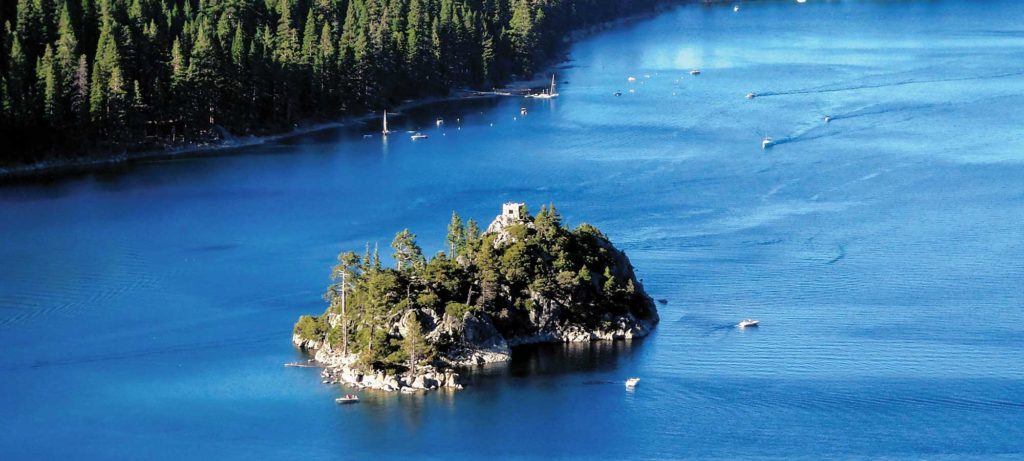
As a Southern California ocean sailor I had never been to Big Blue, the second-deepest lake in America and considered by many to be the most beautiful. But when I saw the endless pine-covered slopes and the majestic mountains that surround Lake Tahoe like a crown, I thought, What took me so long?
The lake has many singular traits. Three hours northeast of San Francisco, it is 22 miles long and 12 miles wide, and it is divided roughly in half by the state line that separates California and Nevada. Tahoe sits at the entrance to the Sierra Nevada, with a surface elevation of 6,200 feet. It is drained by only one river, the Truckee, and it is almost 100 percent pure, like bottled water. It has only one keelboat marina, one island and one true bay, named Emerald. However, the bay is so stunningly beautiful that there is probably no need for any others.
I never associated this lake with sailing, possibly because it’s famous for so many other activities. The 1960 Winter Olympics were held in nearby Squaw Valley. The small towns that line parts of its shores boast more bike, kayak, paddleboard, canoe, raft and personal watercraft rentals than one can count. Water skiers love its usually calm surface. Hikers get lost in places that border it, locations such as Desolation Wilderness. Visitors even attend Shakespeare plays performed on the beach, orchestra concerts played under a tent and pop-rock nights at casinos in Stateline, Nevada. But tacking and reaching under sail? That’s possible too.
With that in mind, my wife, Donna, and our two cousins decided to charter a Catalina 27 on this mythical lake and explore its equally mythic Emerald Bay.
Tahoe Keys Marina, in the small city of South Lake Tahoe, California, is home to dozens of powerboats and perhaps 30 or 40 sailboats, and includes hoists and a popular launch ramp that can accommodate vessels of various sizes. It is also home to Sailing Ventures, a charter company and American Sailing Association-accredited sailing school.
On an August day in 75-degree sunshine, we cast off and headed for the marina’s narrow outlet. A number of factors forced us to pay close attention. The exit passage is about 100 yards long but barely wide enough for two boats, and as it enters the lake, its depth can shrink to less than a foot under the keel of an average sailboat. The marina’s operators told us that nearby idle dredgers were “waiting for permits,” adding that a drought in the Western states was also a reason for the extreme shallowness. (I am still skeptical about the latter since it rained at least briefly almost every afternoon of our 10-day visit to the lake, and hillsides do not stay a glorious jade color without some precipitation.)
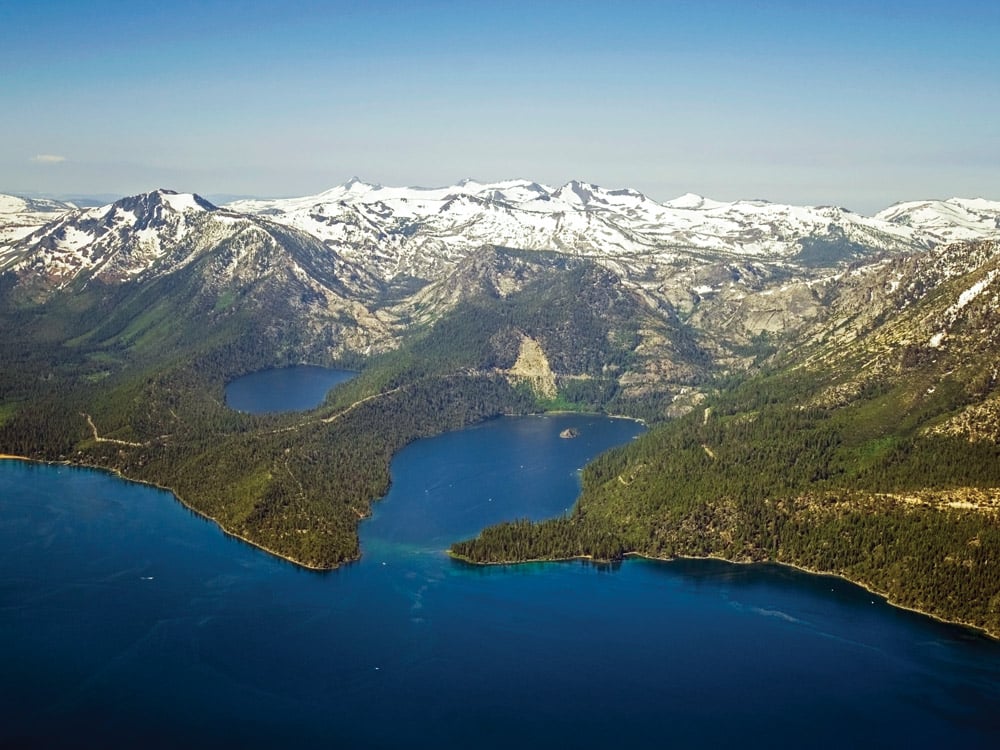
An aerial photograph of Lake Tahoe and Emerald Bay in the summer with Desolation Wilderness still covered in snow, CA.
And then the wonder happened: The depth dropped to 20 feet, 40 feet, 100 feet, 300 feet in less than a minute. We had sailed off a cliff, and soon the thought of even looking at the depth sounder became superfluous. The breeze freshened to about 8 knots out of the northeast, and we glided with eagles through crystal-clear water.
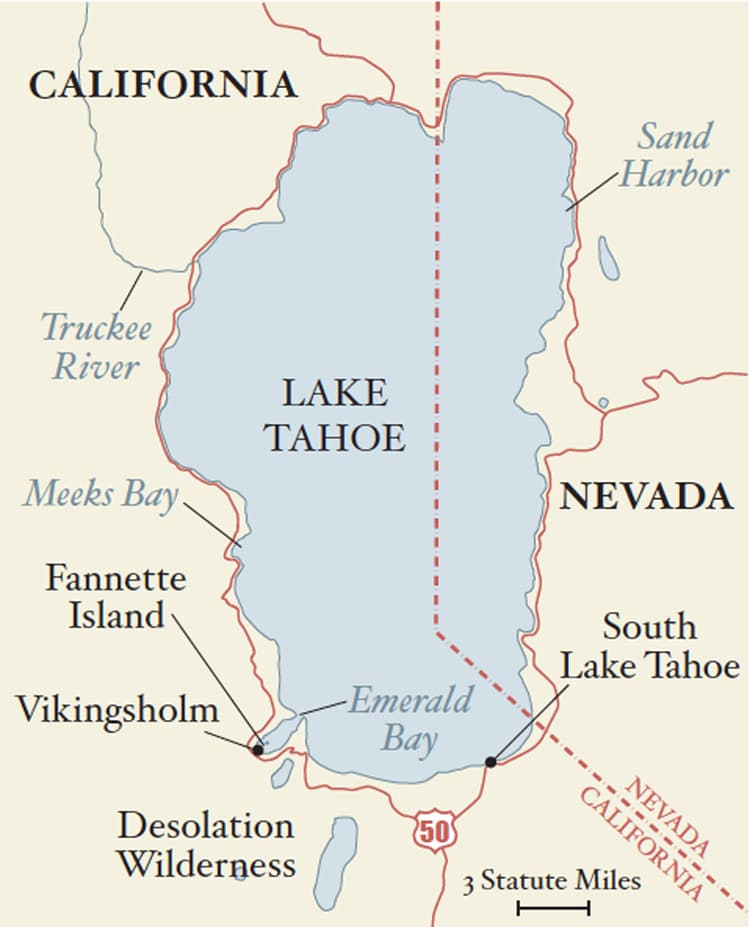
Tahoe’s summer prevailing winds are about equally divided between a morning and midday northerly, followed by a rather consistent afternoon southwesterly coming up from the Pacific. Neither stirs up the lake very much, so they produce ideal sailing: steady breeze with no significant swell. Of course, there are some summer days when the winds never exceed about 5 knots, but after all, this is an alpine lake located 200 miles from the nearest seashore. Gales are rare in summer.
After lunch in the cockpit, cousin Carl declared, “I feel like a Kennedy.” Then we turned the bow northwest and, after about an hour, looked for the downward slope of a mountainside that marks the entrance to Emerald Bay. On this summer afternoon we could have found the entrance just by following a couple of power craft. Before going in, we furled our sails because we were told that winds in the bay either gust and spiral around or become fluky and directionless.
The bay’s entrance was extremely well-marked with red and green buoys, but it proved to be almost as shallow as the entrance to the marina. We watched with fascination — and then with consternation — as the underwater cliff rose to meet us: 250 feet, 100 feet, 35 feet, 10 feet, 7 feet. As though being hurled from the open sea, we cascaded through the little passage, but then once again watched the depth readings increase rapidly. Emerald Bay alone, 2 miles long and a half-mile wide, is deeper than at least one of the Great Lakes.
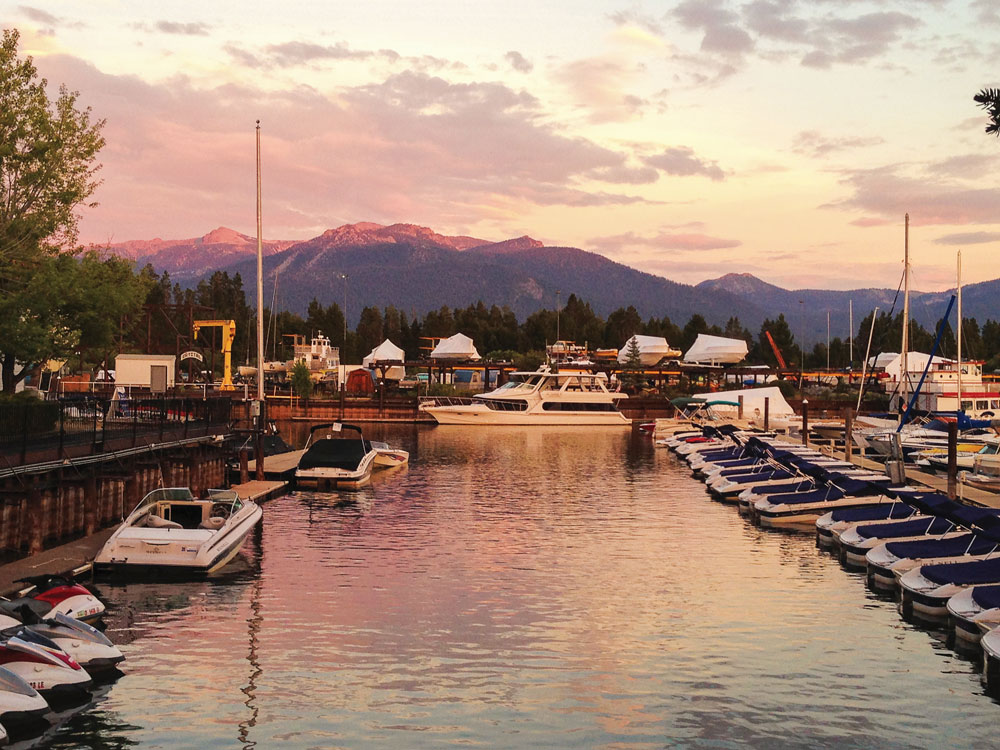
We cruised under power in a clockwise direction, marveling at the awesome Sierra peaks above us and the impossibly clear water below. The winds did increase to perhaps 25 knots as we approached the head of the bay, but they had little effect on the surface of the water. Paddlers gleefully approached, landed on and climbed to the summit of Lake Tahoe’s only island, Fannette, as we circled it. The islet boasts a small castle-like structure called the Tea House at its peak. Now just a stone shell, it was constructed in 1929 by the owner of the bay’s only residence, Lora Knight. She was a wealthy Sweden aficionado, and commissioned a small mansion at the bay’s head and called it Vikingsholm because she saw the body of water as a kind of fjord. She also built this outpost on the island, and would ferry her guests for tea a few times every summer. We wondered what Starbucks would do with the shell if it could convince the National Park Service to sell it.
We had been told that the best place to stop and go ashore was at the mooring field near the bay’s boat-in-only campground. We found more than 20 moorings, most of them open, but they lacked the accompanying pick-up sticks often found at places like California’s Catalina Island. In fact, they lacked pendants and float buoys as well. Instead, each ball featured a metal ring on top. Carl, a former basketball coach, disdained the use of a boat hook that one might normally employ in such a situation. He lay on the foredeck with his right arm over the side, holding a cleated dock line, and said, “I’ll pick up the mooring, just put the damn boat on it.”
I did, and he did as well.
As we sailed, I’d wondered if Tahoe’s water was too cold for swimming. I soon found the answer when the building southwesterly blowing straight down the bay pitched my sandal off the deck and swept it about 100 feet from the boat. Flip-flops are expensive these days, and since Carl’s wife, Kathleen, was daring me to retrieve it, I dived off the stern. The water was surprisingly mild, no colder than, say, the Pacific off Laguna Beach on an average summer day. In fact, the real challenge lay not in adjusting to the temperature but in swimming back against the aforementioned 25-knot wind.
Rowing ashore and landing were child’s play because there is a true sand beach just west of the campground’s pier. The dock itself is in water that is too shallow for most sailboats. It receives plenty of use from powerboaters, though, since the entire bay is accessible only by water; there are no roads down from the highway that circles it 1,000 feet above the shore. Even visitors to the Vikingsholm mansion must walk down a precipitous trail that descends from that height in less than a mile.
I stood on the shore of this unbelievably clear body of protected fresh water and waved to my crewmates lounging in the Catalina’s cockpit. Basking in the sunshine and relishing the 85-degree temperature, I listened to the wind sing down the 10,000-foot-high mountainsides, through vast groves of sugar pines. It was a memorable experience.
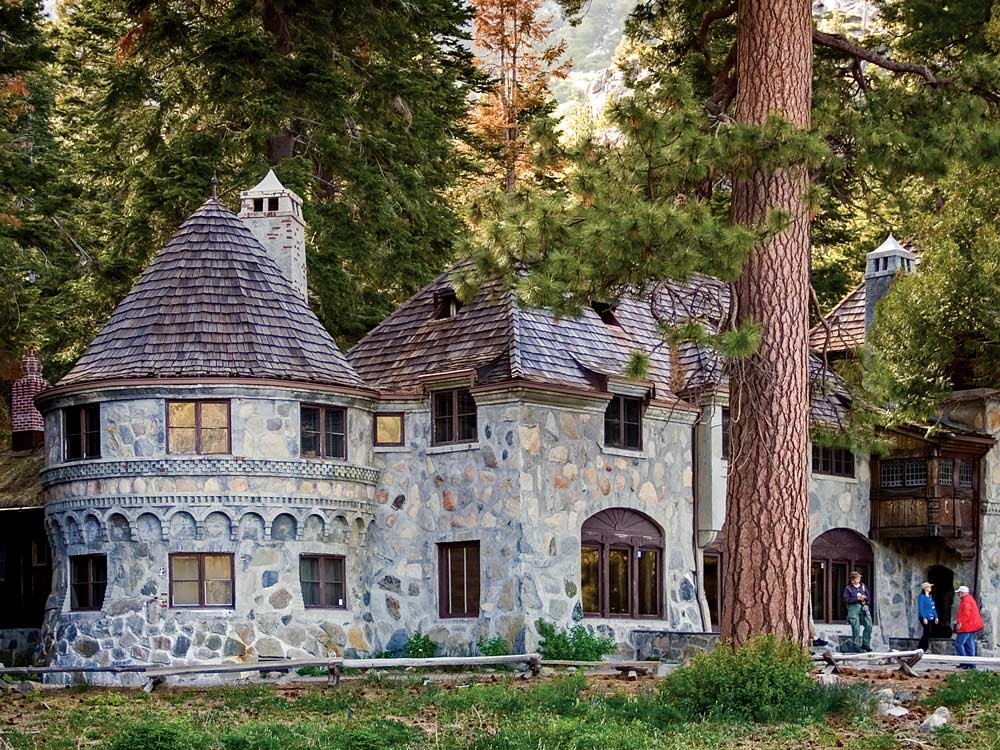
Vikingsholm Castle at Emerald Bay State Park, Lake Tahoe, California.
I’ve enjoyed sailing Puget Sound and the Strait of Georgia, but here there were no swirling mists, icy water, whirlpools, submerged logs or chilling winds. This was the Lake in the Sky, right here in California, and I felt like I had discovered a slice of paradise.
I rowed back, Carl cast off the mooring and we powered through the bay’s shallow entrance as before. Once outside, we raised the sails and they again filled as we heeled sharply, enjoying a goodbye wave from the bay’s steady southwesterly. We reached back across Tahoe, unable to remember why we had waited so long to discover it.
Lawrence Mumford is an American Sailing Association-certified instructor and a university professor. With his wife, Donna, he often sails the bays and islands that extend from Santa Barbara to San Diego, California. Their on-water adventures have taken them to the Pacific Northwest, the Great Lakes, the East Coast and the Baltic.
About the Lake
The Lake Tahoe sailing season runs from about Memorial Day to the end of September, but there might still be snow on the mountainsides into June.
Although the lake has only one true bay, there are several crescent-shaped open roadsteads on both sides that are suitable for anchoring. Examples are Meeks Bay on the west shore and Sand Harbor on the east. Both of these coves have swim buoys that not only protect swimmers, but also act as safe-depth markers for sailboats.
The Fresh Ketch restaurant at the Tahoe Keys Marina is recommended and an easy stroll from most of the docks.
If you go ashore, don’t leave food in your beached dinghy because Tahoe bears are quite interested in such easy pickings. In fact, it is not a good idea to stroll a beach at night eating, say, an apple. At least one visitor has had his snack rudely confiscated by same.
Chartering on Lake Tahoe
We chartered a 27-foot Catalina from Sailing Ventures, located in the Tahoe Keys Marina in South Lake Tahoe. We found it was the only company on the lake that advertises bareboat sailboats for rent. Its fees were quite reasonable, and Michelle Dawn, the director, personally gave us a thorough and unhurried checkout. Rental rates begin at about $250.
Sailing Ventures is also an American Sailing Association school with a full roster of courses and a sister organization on San Francisco Bay. It begins letting boats out around May 15, but reservations can be made at any time of the year: sailingventures.com, PO Box 10583, Reno, NV 89510. Charterers can also call Michelle at 775-287-4356, or send email to michelle@sailingventures.com.
Visit tahoekeysmarina.net for the location of the fuel dock and additional services.
For overnight accommodations, the town boasts at least 50 hotels, motels and cabin complexes ranging in value from luxurious to basic. There are no hotels in the Tahoe Keys Marina itself, but many of the owners of the condominiums and cottages that surround it offer their places for rent during the summer. There are also large public campgrounds on the west side of town.
To fly to the Tahoe Keys Marina, it is best to land in Reno, Nevada, and take the 75-minute, $30 shuttle to South Lake Tahoe. It is a scenic ride over a stretch of the Sierra Nevada. The local Lake Tahoe Airport is used only by private aircraft.
For those visiting by car, there are several good restaurants in the surrounding area, as well as provisioning stores and souvenir shops along U.S. Highway 50.








